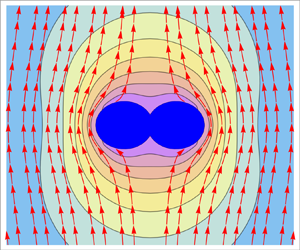Crossref Citations
This article has been cited by the following publications. This list is generated based on data provided by
Crossref.
Pang, Chao
Gai, Yuejun
and
Pan, Wen-Tsao
2022.
Research on Efficiency in Financing of Small and Medium Companies Based on DEA Method.
Discrete Dynamics in Nature and Society,
Vol. 2022,
Issue. 1,
De Fraja, Thomas C.
Rana, Anirudh S.
Enright, Ryan
Cooper, Laura J.
Lockerby, Duncan A.
and
Sprittles, James E.
2022.
Efficient moment method for modeling nanoporous evaporation.
Physical Review Fluids,
Vol. 7,
Issue. 2,
Modi, Atharva
and
Rana, Anirudh Singh
2022.
A finite difference scheme for non-Cartesian mesh: Applications to rarefied gas flows.
Physics of Fluids,
Vol. 34,
Issue. 7,
Gan, Yanbiao
Xu, Aiguo
Lai, Huilin
Li, Wei
Sun, Guanglan
and
Succi, Sauro
2022.
Discrete Boltzmann multi-scale modelling of non-equilibrium multiphase flows.
Journal of Fluid Mechanics,
Vol. 951,
Issue. ,
Lockerby, Duncan A.
2022.
Integration over discrete closed surfaces using the Method of Fundamental Solutions.
Engineering Analysis with Boundary Elements,
Vol. 136,
Issue. ,
p.
232.
Rana, Anirudh S.
and
Barve, Sukratu
2023.
A second-order constitutive theory for polyatomic gases: theory and applications.
Journal of Fluid Mechanics,
Vol. 958,
Issue. ,
Saini, Sonu
Farkya, Ankit
and
Rana, Anirudh Singh
2023.
Thermophoresis and uniform flow in rarefied polyatomic gases: The role of constitutive relations and boundary conditions.
Physics of Fluids,
Vol. 35,
Issue. 9,
Himanshi
Rana, Anirudh Singh
and
Gupta, Vinay Kumar
2023.
Fundamental solutions of an extended hydrodynamic model in two dimensions: Derivation, theory, and applications.
Physical Review E,
Vol. 108,
Issue. 1,
Kumar, Anil
and
Rana, Anirudh Singh
2023.
H
-theorem and boundary conditions for two-temperature model: Application to wave propagation and heat transfer in polyatomic gases.
Physical Review E,
Vol. 108,
Issue. 6,
Farkya, Ankit
and
Rana, Anirudh Singh
2024.
A Novel Meshfree Method for Nonlinear Equations in Flow through Porous Media and Electrohydrodynamic Flows.
Journal of Computational and Theoretical Transport,
Vol. 53,
Issue. 5,
p.
335.
Bhattacharjee, Rahul
Saini, Sonu
Gupta, Vinay Kumar
and
Rana, Anirudh S.
2024.
Rarefied gas flow past a liquid droplet: interplay between internal and external flows.
Journal of Fluid Mechanics,
Vol. 980,
Issue. ,
Spaska, Olena A.
Daszykowski, Michal
and
Bushuev, Yuriy G.
2024.
Evaluation of Evaporation Fluxes for Pesticides and Low Volatile Hazardous Materials Based on Evaporation Kinetics of Net Liquids.
ACS Omega,
Vol. 9,
Issue. 16,
p.
18617.
Himanshi
Rana, Anirudh Singh
and
Gupta, Vinay Kumar
2024.
A Viewpoint on Thermally-Induced Transport in Rarefied Gases through the Method of Fundamental Solutions.
Journal of Computational and Theoretical Transport,
Vol. 53,
Issue. 4,
p.
279.
Jordan, Josiah J.P.
and
Lockerby, Duncan A.
2025.
The method of fundamental solutions for multi-particle Stokes flows: Application to a ring-like array of spheres.
Journal of Computational Physics,
Vol. 520,
Issue. ,
p.
113487.
Kundu, Balaram
and
Yook, Se-Jin
2025.
Advanced modelling for energy transport in solids at both micro and macro dimensions, utilizing relaxation concepts to analyze transient states.
Case Studies in Thermal Engineering,
Vol. 75,
Issue. ,
p.
107172.
Himanshi
Farkya, Ankit
Rana, Anirudh Singh
and
Gupta, Vinay Kumar
2025.
Evaporating jets and phase transition in rarefied conditions.
Physics of Fluids,
Vol. 37,
Issue. 5,
Tang, Qingchun
Pan, Wenjun
Chen, Fengjun
Zhang, Wanshun
Hu, Tian
and
Ma, Zexing
2025.
Advances of simulation and experimental research on fluid polishing of complex internal walls with abrasive grain.
The International Journal of Advanced Manufacturing Technology,
Vol. 140,
Issue. 5-6,
p.
2423.
Himanshi
Rana, Anirudh Singh
and
Gupta, Vinay Kumar
2025.
Exploring external rarefied gas flows through the method of fundamental solutions.
Physical Review E,
Vol. 111,
Issue. 1,
Kumar, Anil
Ahmad, Masrakain
and
Rana, Anirudh Singh
2025.
Coupled constitutive relations for two-temperature model for polyatomic gases: Linear analysis, light scattering, and shock propagation.
Physics of Fluids,
Vol. 37,
Issue. 7,
Farkya, Ankit
and
Rana, Anirudh Singh
2025.
Modeling of rarefied gas flows in streamwise periodic channels: Application of coupled constitutive relations and the method of fundamental solutions.
Engineering Analysis with Boundary Elements,
Vol. 172,
Issue. ,
p.
106108.



